Temple Layout - The shiva temple in Virudhachalam, known as Tirumudukundram, boasts impressive architectural features. Enclosed by walls standing at a towering height of 26 feet, the temple spans 660 feet in length and 390 feet in breadth, making it a grand structure that commands attention. Noteworthy are the four tall gopurams adorning each side of the temple, each consisting of seven levels, adding to the majestic appearance of the temple complex. The eastern gateway serves as the primary entrance, leading visitors into a 16-pillared mandapam. Within the outer most prakaram lies the east-facing sannidhi dedicated to Vinayaka, positioned at a depth of 18 feet. Known as 'Padhaala Vinayakar' due to being underground, this deity is believed to have the power to alleviate shortcomings in one's life, drawing devotees seeking blessings for improvement and prosperity.
The temples known as 'Arupdai Veedu' in connection with Muruga is widely recognized for its significance. Similarly, Vinayaka also has his own collection of six padai veedu. Among these six, 'Padhaala Vinayakar' is considered to be the second 'padaiveedu' for Vinayaka. The female deity of this temple, Periya Nayaki Ammai, has a separate sannidhi facing east in the north side of the first prakaram. Additionally, the third prakaram is home to the idols of the 63 Nayanmars and a sannidhi for Bindu Madhava Perumal. It is worth noting that the Kalabhairava Murtham in this temple bears a striking resemblance to the one in Kasi.
Brahma prayed to Shiva before he commenced his process of creation. Shiva manifested as a hill, for Brahma to replicate, resulting in the formation of the remaining hills and mountains. As this particular hill predates all others that were brought into existence by Brahma, it is recognized as 'Pazhamalai' ("pazhamai" meaning old, and "malai" meaning hill), with Shiva being revered as "Pazhamalainathar".
The sanctum of the presiding deity Pazhamalai Nathar is in the fourth prakaram. Dwarapalakas guard the entrance of the sanctum. Vruthambikai is in the north-west corner of the third prakaram.
Agama Temple - The sacred texts of Shaivism known as ShivAgamas are highly revered alongside the Vedas within the religious tradition. Within this temple, there are 28 Shiva Lingams representing the 28 shivAgamas, which were installed and worshipped by God Muruga himself. These Lingams are housed in a separate sannidhi located in the north-western part of the Kailasa Prakaram, arranged neatly in two rows - southern and western. Ganesha is positioned in the center of the lingams in the southern row, while Muruga and his consorts are placed in the middle of the lingams in the western row. Each of these lingams is named after a specific Agama and are Kamikeshwar, Yogeshwar, Chindiyeshwar, Kaaraneshwar, Ajitheshwar, Deepadeshwar, Sookshameshwar, Sahasreshwar, Amshumaaneshwar, Saprabhadeshwar, Vishayeshwar, Vishwasheshwar, Swayambeshwar, Analeshwar, Veereshwar, Rowraveshwar, Makuteshwar, Vimaleshwar, Chandragyaneshwar, Mukambibeshwar, Purothgeetheshwar, Lalitheshwar, Sidheshwar, Santhaneshwar, Sarvothameshwar, Paremshwar, Kiraneshwar, and Vathuleshwar. This distinctive layout of the lingams has earned the temple the title of 'Agama Temple', highlighting its special connection to the sacred texts and rituals of Shaivism.
The 'sthala vruksham', Vanni (Rusty Acacia), is about 3000 years old. Legend says that sage Vipasittu, plucked the leaves of this Vanni tree and gave them as wages to the laborers for renovating the temple. Remarkably, these leaves miraculously transformed into gold coins, the amount of which corresponded to the extent of labor performed by the workers.
The 14th-century saint poet Arunagirinathar has sung three songs in praise of Lord Muruga. Accompanied by his two consorts Valli and Deivanai, Muruga is seated on a peacock.
When Sundarar sang pathikam on Pazhamalinathar, he was rewarded with 12,000 gold coins. Sundarar was on his way to Tiruvarur and was apprehensive of carrying the gold with him. On Sundarar's request, Pazhamalainathar threw the gold coins into the river (Manimutharu) flowing near by and blessed Sundarar that the coins would be available to him in the 'Kamalalaya theertham' at Tiruvarur.
Skandapurana says that the souls of those who decease here are comforted by Periyanayaki, and Pazhamalainathar Himself preaches the 'Panchakshara mantra'. Hence this place is also known as 'Vruthakasi' - a place which is better than Kasi. It is believed that worshipping at this sacred site allows individuals to accumulate good karma (punniya) equivalent to that gained by visiting Kasi.
Vruthachalam is renowned as a 'Mukthi Sthalam' similar to Kasi. Immersing oneself in 'manimutharu', situated across the north gopuram, and paying homage to Pazhamalinathar is thought to be equally purifying as bathing in the Ganges and worshipping Kasi Vishwanathar. It is believed that the remains of deceased individuals disposed in this river eventually transform into pebbles.
Aadi pooram, Vaikasi Vasantha urchavam, Margazhi tiruvadirai, Masi Makam and Brahmotsavam are a few festivals that are celebrated in grandeur
Saint Gurunamasivaya who lived in the 16th century, Once stayed overnight at Thirumudukundram on his way from Thiruvannamalai to Chidambaram. After visiting Pazhamalai Nathar and Periya Nayaki, he rested in the temple. The saint would always pray to goddess Parvathy whenever he was hungry. Here too he prayed to Periyanayaki by singing her praises, but in his verses he referred to her as an old lady - 'Kizhathi'
"nandri punaiyum periya naayagi enunkizhaththi endrum sivanaarida kizhathi - nindra nilai kizhathi maeny muzhunilak kizhathi malaik kizhathi soru kondu vaa
Periyanayaki appeared before him as an old lady and asked him, "Why did you address me as an old lady? How can an old lady be able to fetch food and water for you?" He then rephrased,
"Muththi nathi soozhum muthugun ruraivaale Bhakthar paniyum pathaththaale - athan idathaale mutra ilamulai melar vadathaale soru kondu vaa"
referring to the goddess as a beautiful young woman. Periyanayaki then appeared as a young woman and fed Gurunamasivaya. The young goddess stands as 'Balambika' in this temple in a dedicated sannidhi.
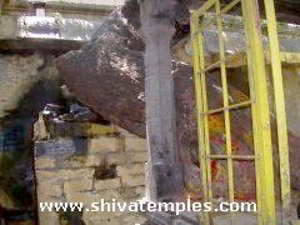 3000 year old vanni tree
3000 year old vanni tree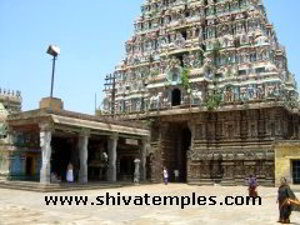 Temple tower and front mandapam
Temple tower and front mandapam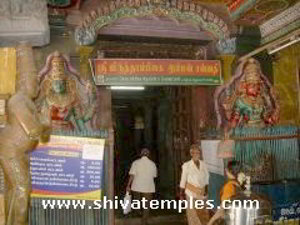 Viruthambikari shrine entrance
Viruthambikari shrine entrance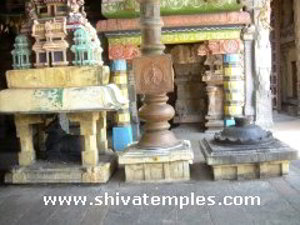 Nandi mandapam,flagpost, balipeetam
Nandi mandapam,flagpost, balipeetam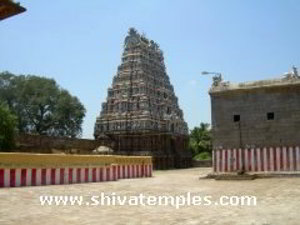 Inside view of the temple
Inside view of the temple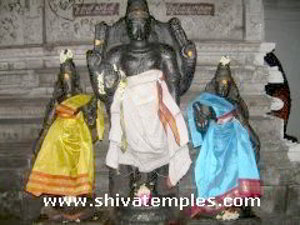 Murugar with his two consorts
Murugar with his two consorts